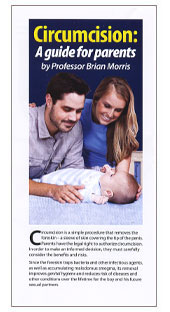Circumcision - Prostate Cancer
A meta-analysis in 2015 found that, after reducing heterogeneity by removing outlier studies, prostate cancer risk was significantly lower in circumcised men, especially in the post-PSA testing era (p=0.01) [Pabalan et al., 2015]. In men of African descent, large US [Wright et al., 2012] and Canadian [Spence et al., 2014] studies showed risk reductions of up to 36% (95% CI 8–61) and 60% (95% CI 0.19–0.86), respectively. Circumcision prevalence worldwide is inversely correlated with prostate cancer incidence [Wachtel et al., 2016]. Countries with high circumcision prevalence have lower prostate cancer-related mortality, corrected for potential confounding factors [Wachtel et al., 2016]. The risk reduction associated with MC is on a par with other commonly recognized factors associated with decreased prostate cancer risk [American Cancer Society 2016; Morris et al., 2007c; Morris & Waskett 2012a].
Prostate cancer accounts for one-quarter of all new cancers in males in the USA (American Cancer Society statistics), Australia and the UK. In the USA, it accounted for 25 deaths per 100,000 men in 2005 (American Cancer Society statistics). In Australia prostate cancer was the cause of 7% of deaths [Australian, 2004a] and in the UK 13% of deaths [Cancer, 2005]. Risk of prostate cancer correlates with a history of sexually transmitted infections (STIs) [Ross et al., 1987; Hayes et al., 2000; Oliver et al., 2001; Dennis & Dawson, 2002; Correa, 2005; Fernandez et al., 2005; Taylor et al., 2005; Radhakrishnan et al., 2007], most consistently syphilis, gonorrhoea, chlamydia and HPV.
HPV causes cervical cancer, but no consistent association has, however, been seen between rate of prostate cancer and rate of cervical cancer in different geographic localities [Ross et al., 1983]. A study of 20,243 men in Finland found infection with HPV18 was associated with a 2.6-fold increase in risk of prostate cancer (P < 0.005) [Dillner et al., 1998]. For HPV16 the increased risk was 2.4-fold. This is similar to the increased penile HPV infection in uncircumcised men [Castellsague et al., 2002]. In contrast, a Swedish study found an association of HPV33, but not HPV 16 or 18, with prostate cancer [Adami et al., 2003]. In a study in Crete, however, HPV was found in only 5% of samples, none of which had the common high-risk types 16 and 18, so making a role for HPV unlikely [Balis et al., 2007]. Consistent with this, a study in Saudi Arabia was unable to detect HPV in any of the prostate biopsies of 56 patients with benign prostatic hyperplasia or prostate cancer [Gazzaz & Mosli, 2009].
The molony murine leukemia virus homologue XMRV (gene: HPC1) was implicated in prostate cancer, initially in patients homozygous for a genetic variant of HPC1 that encodes RNase L, an important component of antiviral defence mechanisms [Urisman et al., 2006]. In a US study of 334 consecutive prostate resection specimens, the DNA for XMRV was found in 6% and XMRV protein expression was found in 23% [Schlaberg et al., 2009]. This retrovirus was found primarily in malignant epithelial cells, consistent with a role in tumorigenesis and tumor aggressiveness. Its presence was, moreover, independent of a polymorphism in the RNase L gene. As well, the polyomavirus BKV has been found in 19% of cases of prostate cancer in Crete, leading to a suggestion that it could play a role in some cases [Balis et al., 2007].
Trichomonas vaginalis, the most common bacterial STI, was positively correlated with risk of prostate cancer later in life in the US Physicians Health Study [Stark et al., 2009]. The study measured antibodies to T. vaginalis in samples collected a decade before prostate cancer was diagnosed. Risk was 2-fold higher for advanced prostate cancer and 3-fold higher for prostate cancer leading to death. There are no symptoms of T. vaginalis infection in most men who have it. A randomized controlled trial has found that circumcision can protect against T. vaginalis infection, this organisms being 46% lower in the men who had been circumcised [Sobngwi-Tambekou et al., 2009b]. In an as-treated analysis, T. vaginalis was even lower, 51%, the adjusted odds ratio being 0.41 [Sobngwi-Tambekou et al., 2009b]. A research team in Berlin, however, failed to find XMRV by PCR in 589 prostate cancers [Hohn et al., 2009]. Others have found an element in the XMRV promoter that causes a doubling of transcription of this gene in response to androgens [Dong & Silverman, 2009].
Such infections may establish in the prostate a state chronic active inflammation, which is associated with a variety of cancers [Correa, 2005]. The rate of STIs has risen over the past decade in many developed countries (e.g., in the UK there are approx. 700,000 cases per year, one-third being in London [Boulos et al., 2005]).
Uncircumcised men have a 1.6 to 2.0 fold higher incidence of prostate cancer compared with circumcised men [Ravich & Ravich, 1951; Apt, 1965; Ewings & Bowie, 1996], and prostate cancer is rare amongst Jews [Alderson, 1986]. In Southern California the reduction in risk in circumcised men was 0.5 in whites and 0.6 in blacks [Ross et al., 1987].
In Sweden, uncircumcised males had twice the risk [Apt, 1965]. Of men operated on for prostatic obstruction, only 1.8% of obstructions were cancerous in Jews (circumcised), compared with 19% of non-Jews [Ravich & Ravich, 1951]. A study in the UK in 1996 found an odds ratio for the reduction in risk in circumcised men was 0.62 [Ewings & Bowie, 1996]. Circumcision rate shows an inverse correlation with prostate cancer incidence in 51 countries (P = 0.022), supporting it having a protective effect against this disease (J.H. Waskett, Manchester, personal communication).
Ascending passage of a particular STI to the prostate could be a causative factor in prostate cancer. An extended clinical trial of the role played by circumcision in the prevention of prostate cancer is needed [Oliver, 2009].
In the USA 1 in 6 men get prostate cancer during their lifetime [American, 2005a]. Annual cases in 2006 were 0.25 million [Laumann et al., 1997]. Average age of diagnosis is 70 years [National, 2006a] and circumcision rate for these men (born in 1933–1947) is approx. 60% [Laumann et al., 1997]. Across the range of a 1.6-2.0 fold increase in risk, calculations show that for these 40% of uncircumcised US men at the average age of prostate cancer diagnosis, there are 24–40% (45–67,000) more prostate cancer cases due to lack of circumcision [Morris et al., 2007].
Treatment by radical prostatectomy leads to shortening in length of the penis by an average of 1.34 cm for the flaccid penis and 2.3 cm (one inch) for the stretched, and continues for a year after surgery [Gontero et al., 2007]. `
The average cost for radiation therapy is US$13,823 [Gregg, 2000] and the combined cost for terminal care for each of the 41,000 who die of prostate cancer each year is $24,660 per patient [Van Howe, 2004]. Thus lack of circumcision adds $0.8–1.6 billion to costs for treatment and terminal care each year in the USA [Morris et al., 2007]. In comparison, the total for (high-end) physician + hospital costs for neonatal circumcision in the USA of $195 represents merely $390 million per year [Van Howe, 2004]. And prostate cancer is just one of the conditions that circumcision provides protection against.



